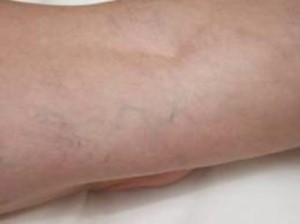What are varicose veins?
Varicose veins are small blue or red swollen veins on the legs. They are usually tiny, with a diameter of one millimetre or less (a.k.a. spider veins or thread veins), but they can also be larger. The tendency to get varicose veins is commonly hereditary and occurs more commonly in women than men (spider veins in particular). Varicose veins are not pretty and can lead to various problems in the long run: pain in the legs, cramps, swollen legs, skin problems or bleeding if you bump your leg. So, in many cases, varicose veins do cause medical problems. Tiny spider veins can also cause problems, for example, they may cause a painful or tender sensation in the legs. In treating varicose veins, attention should be given to both cosmetic and medical aspects as all patients would like to have pretty and healthy legs.
More about the causes and consequences of varicose veins
In terms of their causes, varicose veins are classified into two groups: primary and secondary varicose veins.
Primary varicose veins
Most people have primary varicose veins. Primary varicose veins often have no clear cause and usually involve a tendency which also occurs in other family members. Probably as a result of this (genetically determined) tendency, the vein wall is slightly weaker and the tiny valves in the vein, which should transport the blood upwards, are less strong. Consequently, the blood in the veins is transported less easily, which may cause swelling of the veins. Certain factors, such as pregnancy or work that requires prolonged standing, may aggravate varicose veins.
Secondary varicose veins
Secondary varicose veins occur after a disorder such as thrombosis in the leg (blood clot). This occurs in a minority of people. There are varicose veins in all sizes, from tiny spider veins to large veins with a diameter of several centimetres. Not all veins are visible. Tiny spider veins often link up with larger veins beneath the skin which are not visible to the eye. These veins can also cause problems. When examining varicose veins, we therefore also perform an ultrasound duplex scan to examine the internal veins.
Small varicose veins
Small varicose veins are superficial and small dilated blood vessels a few millimetres thick. Small varicose veins are recognisable by their bright colour and often blow out from 1 point. For this reason, small varicose veins are also called broom grey or branchial forest. These varicose veins no longer have a function in draining blood.
Small varicose veins are usually treated with injections (sclerocompression therapy). The very smallest (remaining) red vessels can still be treated with a skin laser.


Medium-sized varicose veins
Medium-sized varicose veins are usually bulging, dilated blood vessels that lie on the legs, so to speak. Medium-sized varicose veins occur in the so-called connection veins; these veins are larger than the thin, smaller veins in which small varicose veins occur. These veins form a connection between the superficial and deep veins.
Treating medium-sized varicose veins is usually done with injections or ambulatory phlebectomy according to Muller.
Large varicose veins
Large varicose veins look like tortuous blood vessels lying on the leg. Large varicose veins may also not be visible but can be felt. They are also called cables, because of the thickness of the varicose vein.
Treatment of large varicose veins usually requires endovenous ablation (EVLT). Large varicose veins are also sometimes treated with ambulatory phlebectomy according to Muller.
Foamsclerosis is a newer variant of injecting varicose veins. Instead of liquid, a foam is used. This foam acts more strongly than the liquid. Foamsclerosis therefore allows larger varicose veins to be injected.
Treat varicose veins at MC Wetering
Medical Centre Wetering specialises in the treatment of varicose veins. There is a phlebology team, consisting of two dermatologists, a phlebologist, a surgeon and two vascular lab technicians. The doctors have gained a lot of experience in phlebology at various hospitals and Dr Krijnen has a PhD on the subject. The doctors have combined their expertise in this person-centred centre where high quality is provided by a permanent team of medical specialists.
Frequently asked questions about varicose veins
Why do I get varicose veins?
Most people who suffer from varicose veins get them for no apparent reason. One may have a genetic predisposition to it, or it may be due to standing for long periods of time. Conditions such as thrombosis can also cause varicose veins.
Do varicose veins disappear on their own?
Once you have varicose veins, they do not disappear by themselves. If you suffer from varicose veins or find them aesthetically unattractive, we can help you get rid of them.
What can I do to prevent varicose veins myself?
The best thing you can do to combat varicose veins is to keep moving. If you do a lot of sitting or standing while working, take regular walks between jobs, or do leg exercises. For example, turn your foot in circles to activate your calf muscles.
Waiting time indication
Dermatology
Days
Gynaecology
Days
Proctology
Days
Phlebology
Days
Plastic surgery
Days








